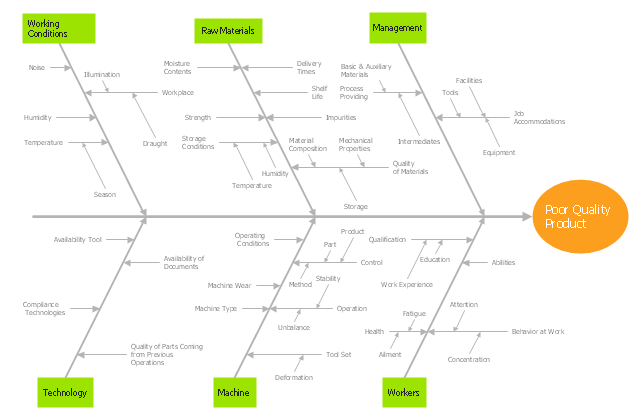 Fishbone Diagram
Fishbone Diagram
Fishbone Diagrams solution extends ConceptDraw PRO software with templates, samples and library of vector stencils for drawing the Ishikawa diagrams for cause and effect analysis.
 Management
Management
This solution extends ConceptDraw PRO v9 and ConceptDraw MINDMAP v7 with Management Diagrams and Mind Maps (decision making, scheduling, thinking ideas, problem solving, business planning, company organizing, SWOT analysis, preparing and holding meetings
"Ishikawa diagrams (also called fishbone diagrams, herringbone diagrams, cause-and-effect diagrams, or Fishikawa) are causal diagrams created by Kaoru Ishikawa (1968) that show the causes of a specific event. Common uses of the Ishikawa diagram are product design and quality defect prevention, to identify potential factors causing an overall effect. Each cause or reason for imperfection is a source of variation. Causes are usually grouped into major categories to identify these sources of variation. The categories typically include:
- People: Anyone involved with the process
- Methods: How the process is performed and the specific requirements for doing it, such as policies, procedures, rules, regulations and laws
- Machines: Any equipment, computers, tools, etc. required to accomplish the job
- Materials: Raw materials, parts, pens, paper, etc. used to produce the final product
- Measurements: Data generated from the process that are used to evaluate its quality
- Environment: The conditions, such as location, time, temperature, and culture in which the process operates" [Ishikawa diagram. Wikipedia]
The fishbone diagram example "Causes of low-quality output" was created using the ConceptDraw PRO diagramming and vector drawing software extended with the Fishbone Diagrams solution from the Management area of ConceptDraw Solution Park.
- People: Anyone involved with the process
- Methods: How the process is performed and the specific requirements for doing it, such as policies, procedures, rules, regulations and laws
- Machines: Any equipment, computers, tools, etc. required to accomplish the job
- Materials: Raw materials, parts, pens, paper, etc. used to produce the final product
- Measurements: Data generated from the process that are used to evaluate its quality
- Environment: The conditions, such as location, time, temperature, and culture in which the process operates" [Ishikawa diagram. Wikipedia]
The fishbone diagram example "Causes of low-quality output" was created using the ConceptDraw PRO diagramming and vector drawing software extended with the Fishbone Diagrams solution from the Management area of ConceptDraw Solution Park.
- Fishbone Diagram | Management | PM Response | - Conceptdraw .com
- Fishbone Diagram | Business Productivity Diagramming | Business ...
- Fishbone Diagram | Business Productivity Diagramming | Business ...
- SWOT Sample in Computers | Fishbone Diagram | Restaurant Floor ...
- Fishbone Diagram | Management | ConceptDraw Solution Park |
- Value Stream Mapping | Quality | Fishbone Diagram |
- Fishbone Diagram | How to Draw a Computer Network Diagrams ...
- Best Vector Drawing Application for Mac OS X | Fishbone Diagram ...
- Fishbone Diagram | Telecommunication Network Diagrams | Cisco ...
- Fishbone Diagram | Business Process Diagram | How to Draw a ...
- Fishbone Diagram | Enterprise Architecture Diagrams | AWS ...
- ConceptDraw Solution Park | Fishbone Diagram | SWOT Analysis |
- Fishbone Diagram | Business Productivity Diagramming ...
- Cause and Effect Analysis ( Fishbone Diagrams )
- Cause and Effect Analysis ( Fishbone Diagrams ) | Fishbone Diagram ...
- How to Draw an Organization Chart | Fishbone Diagram ...
- Fishbone Diagram | Total Quality Management with ConceptDraw ...
- Building Drawing Software for Design Office Layout Plan | How To ...
- Workflow Process Example | Fishbone Diagram | Process Flowchart |
- Fishbone Diagram | Business Productivity Diagramming | Cause ...
